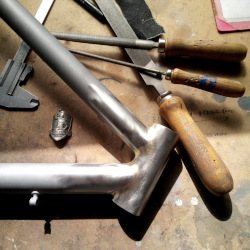Understanding the Problem: Arm Length Differences and Postural Imbalances
Every human body is unique, and even small asymmetries can significantly affect posture and comfort on the bike. My friend's issue was a noticeable discrepancy in arm lengths, which caused misalignment of the shoulders on the handlebar. This imbalance led to discomfort, reduced efficiency, and an increased risk of tension or long-term injuries.
In traditional setups, handlebars are designed symmetrically, assuming both arms can apply force in parallel. However, for those with differing arm lengths, this symmetry fails, leading to compensated postures and muscle strain. Solving this problem required a custom solution tailored to my friend’s body characteristics.
The Design Process: From Concept to Reality
The first step was a thorough evaluation of the problem, which involved:
- Measuring the Asymmetry: Using precision tools, I measured the difference in arm lengths and analyzed its impact on shoulder alignment during a typical riding position. These measurements served as design parameters.
- Understanding the Riding Style: Being a long-distance enthusiast, my friend needed a solution that prioritized not only symmetry but also long-term comfort.
- Prototyping: I drafted several design options, considering functionality, aesthetics, and material durability. The chosen design integrated an adjustable support system to compensate for the arm length difference while maintaining handlebar ergonomics.
Placeholder for Image 1: Initial Sketches and Measurements
Bringing the Solution to Life: Materials and Craftsmanship
For this project, I selected lightweight yet durable materials. The handlebar support needed to ensure stability without adding excessive weight, which could alter riding dynamics. Stainless steel was the primary material due to its longevity, corrosion resistance, and compatibility with other bike components.
The fabrication process involved:
- Cutting and Shaping: Using precision tools, I cut and shaped the steel based on the custom measurements.
- Welding: The welding had to be flawless to ensure robustness and a refined aesthetic. This stage required great attention to avoid weak points.
- Adjustable Mechanism: I integrated an adjustable feature to allow minor position adjustments over time.
- Finishing: After the structural work, I polished the steel to achieve a clean, professional look. The final result was not only functional but also visually aligned with the bike’s overall design.
Placeholder for Image 2: Fabrication Process
Testing and Final Adjustments
Once the support was installed, it was time to test it under real conditions. My friend took the bike on various routes, providing feedback on comfort, stability, and any residual issues. Adjustments focused on:
- Ensuring the support provided the correct elevation and angle correction.
- Verifying that the material did not cause vibrations or discomfort during rides.
- Confirming the design integrated perfectly with the existing handlebar setup.
The result? A clear improvement in posture, reduced shoulder strain, and a more enjoyable overall cycling experience.
Placeholder for Image 3: Custom Support Installed
The Impact of Custom Solutions in Cycling
This project highlights the importance of adapting bicycle components to individual needs. While the cycling industry offers a wide range of adjustable products, there are moments when only a truly bespoke solution will suffice. Whether addressing ergonomic challenges, optimizing performance, or improving comfort, custom craftsmanship can make a significant difference.
Conclusion
This custom handlebar support is a testament to the value of craftsmanship in cycling. By tackling a specific ergonomic challenge, I enhanced my friend’s riding experience, proving once again that the right tools, designed with care and precision, can transform the way we ride.
If you’re curious about custom cycling solutions or have a specific problem you’d like to solve, don’t hesitate to contact me. Together, we can create something that is not only functional but truly unique.








 Every frame I craft is tailored to your unique needs and preferences, ensuring a perfect fit and unmatched performance
Every frame I craft is tailored to your unique needs and preferences, ensuring a perfect fit and unmatched performance